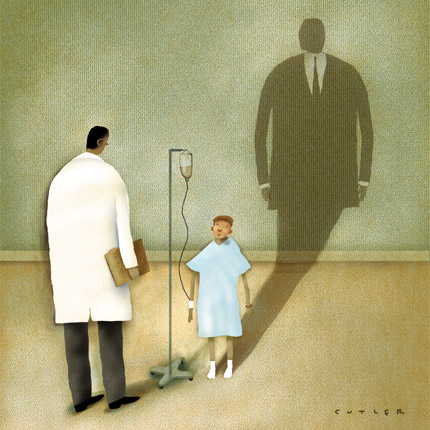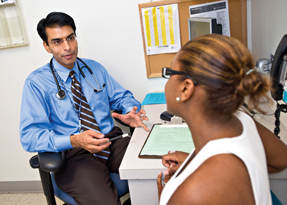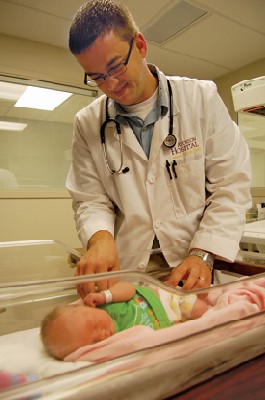History is key after childhood disease
A generation ago, most children with severe disabilities died before reaching adulthood. Now, more than 90% survive. From cancer or congenital heart disease to cystic fibrosis and Down syndrome, pediatric survivors need interns who can coordinate chronic care.
For people who have survived a childhood disease and those living with a chronic disease or disability, making a successful transition to adult health care means finding a physician who is informed about the special and sometimes surprising challenges ahead.
“They need someone who will quarterback their care,” said Bradley J. Benson, FACP, director of the division of general internal medicine at the University of Minnesota in Minneapolis. “These patients have different primary and preventive care needs based on their childhood diagnosis.”

For internists, who are increasingly becoming the medical home for such patients, staying informed about their needs is crucial. And they'll be facing this issue more often, according to Niraj Sharma, FACP, director of the internal medicine-pediatrics residency program at Harvard Medical School in Boston. Speaking at Internal Medicine 2010 in Toronto, Dr. Sharma said that internists “need to prepare for this tidal wave [of patients] about to crash on our shores.”
Statistics back up his assertion. A generation ago, most children with severe disabilities died before they reached adulthood; now more than 90% survive. Also:
- About half a million children with special health care needs enter adulthood each year (Pediatrics. 2002;110:1304-6).
- The 5-year survival rate of childhood cancer is 80%; 46% of childhood cancer survivors are now 20 to 40 years old; 18% are older than 40 (The Oncologist. 2008;13:1181-192).
- The Spina Bifida Association notes that 85% of children with spina bifida reach adulthood.
- 45% of patients with cystic fibrosis are now older than age 18; average life expectancy has increased from 7 years in 1970 to over 37 years in 2007, according to the Cystic Fibrosis Foundation.
- Since 2005, according to the 32nd Bethesda Conference Guidelines, more adults than children have congenital heart disease, and that adult population increases about 5% each year.
- Life expectancy for children with Down syndrome was age 25 in 1983 and is age 55 today, the National Down Syndrome Society reports.
- Children with sickle-cell disease, who had a life expectancy of 14 years in 1973, are now surviving into their 50s and longer, according to the Sickle Cell Disease Association of America.
- Children diagnosed with HIV/AIDS are living into adulthood.
A consensus statement issued by the American College of Physicians and other groups in 2002 (Pediatrics. 2002;110:1305-6) outlined the changes needed in health care delivery as more people with special health care needs transition to adulthood. The statement called on pediatric and adult health care practitioners to work together to ensure that all young people have “uninterrupted, comprehensive, and accessible care within their communities.”
Cure comes with a price
For childhood cancer survivors, especially, internists need to be aware of complications resulting from earlier treatment. According to the Institute of Medicine's 2003 statement, “Childhood Cancer Survivorship: Improving Care and Quality of Life,” aggressive treatment of childhood cancer in the 1980s increased survival rates but also increased late effects throughout life. “The impressive gains in survival have been achieved at a price,” the report stated.
For children who receive chemotherapy, radiation and surgery, the “implications of cure are not trivial,” according to Smita Bhatia, MD, MPH, and Wendy Landier, RN, MSN, both at the City of Hope National Medical Center in Duarte, Calif. Their recent report on the morbidity burden of pediatric cancer in adulthood stated that two-thirds of survivors will have at least one late effect and about one-third will have a severe or life-threatening late effect of the treatment. These patients have a sixfold higher risk of developing a second cancer, with the most common second malignant neoplasms being breast, thyroid and bone cancers (N Engl J Med. 2006;355:1572-82).
“For a young woman who was diagnosed at age 3 with Hodgkin's disease, her likelihood of having a disability or serious medical condition 30 years down the road is very high. She has a 1 in 4 chance of getting breast cancer by age 40. A young man who was diagnosed with Hodgkin's in childhood has a much greater chance of having a heart attack by age 25,” Dr. Benson said.

In addition to subsequent malignancies, impairment in growth and development, neurocognitive dysfunction, cardiopulmonary compromise, endocrine dysfunction, renal impairment, gastrointestinal dysfunction and musculoskeletal sequelae are also common. According to Dr. Bhatia and Ms. Landier, patients at greatest risk for late effects of cancer are those who were treated for Hodgkin's disease or brain tumors and those who received chest radiation and anthracyclines as children. This group has an eightfold higher risk of a severe chronic health condition when compared with age- and sex-matched siblings (The Oncologist. 2008;13:1181-92).
“These patients are a ticking time bomb,” Dr. Benson said. “The patient may look in perfect health, is functioning and has put this experience with cancer behind him. They are just expected to thrive.” Instead, they may have fertility issues, anxiety, depression and post-traumatic stress related to their childhood experience with cancer.
Adults with Down syndrome, too, have special health care needs as they age. Even though they often fare well medically in their early adult years, they are at risk for other health conditions later in life, including hypothyroidism and Alzheimer's by middle age. Internists should especially be on the lookout for heart problems in Down syndrome patients, who have a very high rate of congenital heart defects.
Easier said than done
For all survivors of pediatric disease, a complete health history is key, experts said. Getting one is easier said than done, however, since many patients have little to no information about the treatments they received as children.
According to some estimates, about 72% of cancer survivors can accurately report their cancer diagnosis, and about that same percentage can tell a doctor the specific site where they received radiation. Few can give the radiation dose or other specific information about chemotherapy.
“For someone who was diagnosed with leukemia at age 3, the likelihood of their remembering what they got is zero,” Dr. Benson said. “I never rely on their verbal information.”
Most families, after their child has recovered from cancer, speak little about the disease or the treatment, according to Dr. Benson. A further complicating factor is that young adults who had a serious disease in childhood may not understand or accept that there can be serious health problems as a result of their past treatment. Some may assume they have been cured and no longer need follow-up care.
For patients with Down syndrome, the issue can be complicated by placement issues. “Some come with a very good history and some with none at all,” said William Hopkins, FACP, director of the Adults with Down Syndrome Program at the University of Vermont in Burlington. “Some show up with their parents because they live with them their entire life, while others were institutionalized at an early age and are now part of a foster care management program.”
Don't go it alone
In obtaining a health history, and in other aspects of caring for a childhood disease survivor, an internist shouldn't operate in isolation, experts said.
With survivors of pediatric cancer, for example, “It is very important that the internist maintain close communication with the pediatric oncologist who has taken care of the patient,” Dr. Bhatia said. “There should be an open dialogue so that they can both coordinate the care of the patient, especially as that patient is transitioning to adult care.”
Young adults with cystic fibrosis can benefit from the more than 110 cystic fibrosis care centers around the U.S., which can also provide support to internists.
“One key to the success in cystic fibrosis has been development of this care center network where patients are seen at specialized centers that have a lot of experience treating and managing cystic fibrosis,” said Daniel B. Rosenbluth, MD, director of adult cystic fibrosis services at Washington University School of Medicine in St. Louis.
According to Dr. Rosenbluth, an internist treating an adult with cystic fibrosis should be seeing them in conjunction with a care center. “Developing protocols and standards of care in a multidisciplinary approach with nutritionists, social workers [and] nurses is essential,” he said.
Patients with Down syndrome, too, will need support from a care team. As they age, the focus shifts from developmental and learning-based issues to more medical ones, Dr. Hopkins said. Since adults with Down syndrome can now live into their 60s, they fare better if they can become part of a community service, with help from a caseworker who can serve as an advocate for the patient.
Becoming a medical home
Often, Dr. Sharma said, the medical home is considered a concept that applies only to older adults on Medicare. But it's equally important for young adults who have survived a serious disease or are living with chronic conditions. According to experts, there are steps an internist can take to become an effective medical home for this population.
- First, understand that the needs of these patients are different and that their care must be tailored to fit those needs.
- Take a detailed history, and if you can't, refer the patient to a long-term follow-up center that can work up a complete history.
- Do some “sleuthing” on your own when needed, including requesting release of medical information from the patient's former pediatrician or specialist when warranted.
- Maintain close communication with the patient's previous pediatric specialists to help facilitate care transition, and help coordinate contact with current specialists.
- Develop a portable health record for the patient that gives specifics of past and current medical history.
- Develop a long-term screening and care plan based on the patient's specific condition (e.g., chemotherapy regimen and radiation exposure in a cancer patient, or congenital heart defects in a patient with Down syndrome).
Internists should also remember that survivors of childhood disease often have strong bonds with the doctors who treated them early in life and may need some help themselves in switching to a different kind of care.
“They don't simply need to transition from a pediatric specialist to an adult specialist or from a pediatrician to an internist,” Dr. Benson said. “Instead, they need to transition from a pediatric model of care where their mom or dad makes the appointment and they are surrounded by the kind of care they need to an adult model of care where they take ownership of their own health care needs.”





